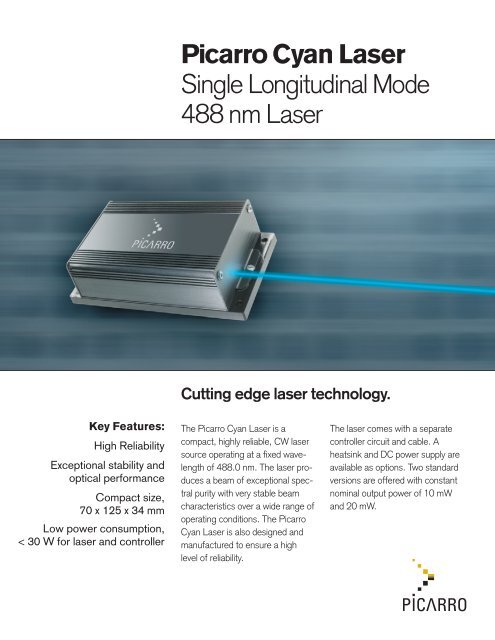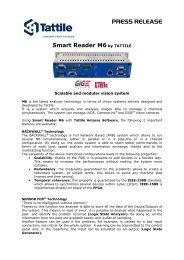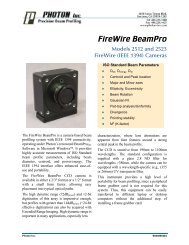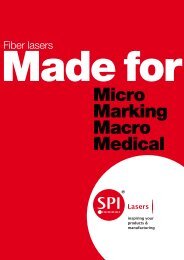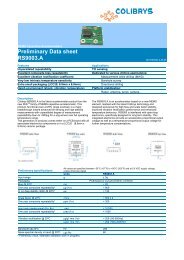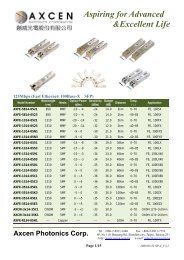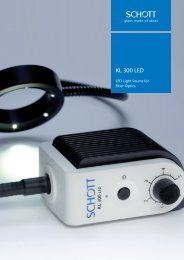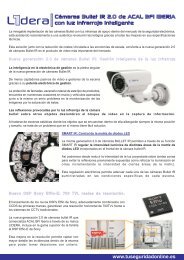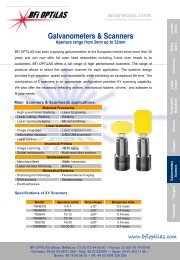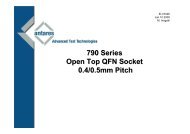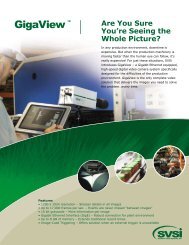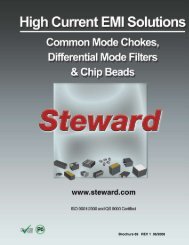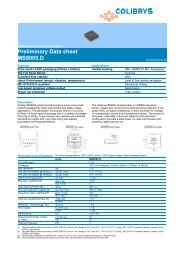Picarro Cyan Laser Single Longitudinal Mode 488 nm Laser
Picarro Cyan Laser Single Longitudinal Mode 488 nm Laser
Picarro Cyan Laser Single Longitudinal Mode 488 nm Laser
You also want an ePaper? Increase the reach of your titles
YUMPU automatically turns print PDFs into web optimized ePapers that Google loves.
<strong>Picarro</strong> <strong>Cyan</strong> <strong>Laser</strong><br />
<strong>Single</strong> <strong>Longitudinal</strong> <strong>Mode</strong><br />
<strong>488</strong> <strong>nm</strong> <strong>Laser</strong><br />
Cutting edge laser technology.<br />
Key Features:<br />
High Reliability<br />
Exceptional stability and<br />
optical performance<br />
Compact size,<br />
70 x 125 x 34 mm<br />
Low power consumption,<br />
< 30 W for laser and controller<br />
The <strong>Picarro</strong> <strong>Cyan</strong> <strong>Laser</strong> is a<br />
compact, highly reliable, CW laser<br />
source operating at a fixed wavelength<br />
of <strong>488</strong>.0 <strong>nm</strong>. The laser produces<br />
a beam of exceptional spectral<br />
purity with very stable beam<br />
characteristics over a wide range of<br />
operating conditions. The <strong>Picarro</strong><br />
<strong>Cyan</strong> <strong>Laser</strong> is also designed and<br />
manufactured to ensure a high<br />
level of reliability.<br />
The laser comes with a separate<br />
controller circuit and cable. A<br />
heatsink and DC power supply are<br />
available as options. Two standard<br />
versions are offered with constant<br />
nominal output power of 10 mW<br />
and 20 mW.
<strong>Single</strong> <strong>Longitudinal</strong> <strong>Mode</strong><br />
<strong>488</strong> <strong>nm</strong> <strong>Laser</strong><br />
Description<br />
The <strong>Picarro</strong> <strong>Cyan</strong> <strong>Laser</strong> is based on a simple<br />
yet elegant design concept that delivers<br />
exceptional optical performance and high<br />
reliability in a compact laser head. From conception<br />
the laser optical assembly, materials,<br />
manufacturing processes and electronic<br />
controls have been designed for high reliability.<br />
The laser configuration is a directly<br />
doubled external cavity semiconductor laser<br />
(DECSL). Figure 1 shows a simplified block<br />
diagram of the <strong>Laser</strong>.<br />
The two key elements comprising the laser<br />
are 1) a compact and stable external cavity<br />
laser assembly incorporating a high power,<br />
highly reliable semiconductor gain chip and<br />
2) a reliable and efficient extra-cavity second<br />
harmonic generating (SHG) crystal. These<br />
elements are contained in a hermetically<br />
sealed laser sub-assembly.<br />
Hermetic <strong>Laser</strong> Head Assembly<br />
EXTERNAL CAVITY LASER<br />
SEMICONDUCTOR GAIN CHIP<br />
SHG CRYSTAL<br />
976 <strong>nm</strong> LIGHT<br />
<strong>488</strong> <strong>nm</strong> LIGHT<br />
Figure 1<br />
Stable External Cavity <strong>Laser</strong><br />
The <strong>Picarro</strong> <strong>Cyan</strong> <strong>Laser</strong> uses a single spatial<br />
mode semiconductor chip to directly generate<br />
976 <strong>nm</strong> light. This differs from other<br />
solid-state blue lasers that use high power<br />
multi-mode laser diodes to pump a second<br />
medium, such as an Nd:YAG crystal or a vertical<br />
cavity semiconductor chip, which in turn<br />
generates light at 946 <strong>nm</strong> or 976 <strong>nm</strong> respectively.<br />
The <strong>Picarro</strong> laser eliminates this step<br />
entirely by directly generating 976 <strong>nm</strong> light<br />
from a highly reliable semiconductor gain<br />
chip. The chips used by <strong>Picarro</strong> were originally<br />
designed and qualified for use in high<br />
reliability applications such as fiber optic<br />
communications networks that require continuous<br />
operation for 20 years or more.<br />
The external cavity laser converts the single<br />
spatial mode output from the gain chip into a<br />
stable single spatial and longitudinal mode<br />
beam at 976 <strong>nm</strong>. The external cavity is constructed<br />
with no moving parts and a simple<br />
wavelength selection scheme. A thermoelectric<br />
cooler (TEC) is used to maintain the<br />
cavity in an optimum operating condition over<br />
a wide range of ambient conditions. Since<br />
the SHG crystal is not included inside the<br />
laser cavity, the monitors and electronic controls<br />
needed to maintain stable laser operation<br />
are greatly simplified when compared to<br />
intra-cavity doubling schemes used in other<br />
laser designs. Simplified monitoring and<br />
control result in more stable and reliable<br />
operation over time and a wide range of<br />
operating temperatures.<br />
Efficient Second Harmonic<br />
Generating (SHG) Crystal<br />
The excellent optical characteristics and<br />
stable performance of the 976 <strong>nm</strong> external<br />
cavity laser make it possible to use a highly<br />
efficient SHG material in a simple extra-cavity<br />
frequency doubling scheme. By performing<br />
frequency doubling outside the laser cavity,<br />
the SHG crystal performance can be independently<br />
monitored and controlled resulting<br />
in very stable performance. The use of highly<br />
efficient doubling material in an extra-cavity<br />
geometry also results in much lower optical<br />
flux density in the SHG crystal when compared<br />
to intra-cavity doubling schemes.<br />
Lower optical flux density results in longer<br />
crystal lifetime and greater performance stability.<br />
A separate TEC controls the temperature<br />
of the SHG crystal ensuring stable performance<br />
over time and a wide range of<br />
ambient conditions.
Performance<br />
The unique design features of the <strong>Picarro</strong><br />
<strong>Cyan</strong> <strong>Laser</strong> result in exceptional optical performance<br />
as well as outstanding reliability.<br />
Figure 2 shows a typical output spectrum<br />
plot from a <strong>Picarro</strong> laser featuring a narrow<br />
single longitudinal mode and high suppression<br />
of spurious modes. A narrow spectrum<br />
with a very stable center frequency can be<br />
beneficial in spectroscopic applications such<br />
as fluorescence excitation.<br />
INTEGRATED NOISE (20Hz–2MHz, RMS, %)<br />
0.30<br />
0.25<br />
0.20<br />
0.15<br />
0.10<br />
0.05<br />
Spec. limit (0.25%)<br />
0<br />
-10<br />
Power in Band 99.997%<br />
λ 0 = <strong>488</strong>.04 <strong>nm</strong><br />
0.00<br />
0.0 0.2<br />
0.4 0.6 0.8 1.0<br />
TIME (Hrs)<br />
Figure 3<br />
INTENSITY (dBm)<br />
-20<br />
-30<br />
-40<br />
-50<br />
-60<br />
-70<br />
-80<br />
460 470<br />
480 490 500 510 520<br />
WAVELENGTH (<strong>nm</strong>)<br />
Other laser characteristics of critical importance<br />
for many laser based instruments and<br />
measurements are beam pointing stability,<br />
output power stability, spatial mode quality<br />
and total power dissipation. The <strong>Picarro</strong><br />
<strong>Cyan</strong> <strong>Laser</strong> performance specifications for<br />
these parameters and others are detailed in<br />
the Specification section of this brochure.<br />
Figure 2<br />
<strong>Laser</strong> intensity noise is another characteristic<br />
that can be important in scattering measurements<br />
or printing applications. Figure 3<br />
shows typical integrated RMS intensity noise<br />
performance for the <strong>Picarro</strong> <strong>Cyan</strong> <strong>Laser</strong>.<br />
Reliability<br />
At <strong>Picarro</strong> we have implemented design for<br />
reliability (DFR) practices in the development<br />
of our product and manufacturing process.<br />
The components and materials used in our<br />
lasers have been selected and rigorously<br />
tested to achieve specific reliability objectives.<br />
DFR tools such as Tolerance Analysis<br />
and Failure <strong>Mode</strong> Effects Analysis (FMEA)<br />
have been extensively used in the product<br />
design, materials selection, component<br />
specification and process development.<br />
Accelerated life testing, enviro<strong>nm</strong>ental<br />
testing and overstress testing have been<br />
conducted on key components, subassemblies<br />
and the complete laser module. The<br />
combined data and knowledge from this reliability<br />
analysis and testing have been used to<br />
develop appropriate screening, burn-in,<br />
process control and surveillance strategies<br />
to assure a high level of reliable performance<br />
from our lasers. These efforts have resulted<br />
in an estimated mean time to failure (MTTF)<br />
for the <strong>Picarro</strong> <strong>Cyan</strong> <strong>Laser</strong> of greater than<br />
20,000 hours. This level of reliability can significantly<br />
reduce the cost and inconvenience<br />
of repeatedly replacing laser heads and laser<br />
tubes during the lifetime of an instrument.<br />
Other laser designs typically exhibit MTTF<br />
values of only 5,000 to 10,000 hours.
Specifications<br />
Enviro<strong>nm</strong>ental and Absolute<br />
Maximum Ratings<br />
Parameter Min Max Units<br />
Storage Temperature –30 70 ºC<br />
Storage relative humidity * 0 100 %<br />
Ambient Operating Temperature 4 40 ºC<br />
Case Operating Temperature 4 55 ºC<br />
Operating relative humidity * 0 90 %<br />
Non-Operating Altitude 0 70,000 feet<br />
Operating Altitude 0 10,000 feet<br />
+12V Supply pin voltage (+12V rail with respect to GND) -0.3 13 V<br />
-12 V Supply pin voltage (-12V rail with respect to GND) 0.3 -13 V<br />
5 V Supply pin voltage (5V rail with respect to GND) -0.3 5.8 V<br />
Warm Up Time from OFF
System Integration and Thermal Management<br />
THERMAL IMPEDANCE (C/W)<br />
1<br />
0.9<br />
0.8<br />
0.7<br />
0.6<br />
0.5<br />
0.4<br />
0.3<br />
0.2<br />
0.1<br />
0<br />
HEATSINK PERFORMANCE<br />
20 25 30 35 40 45 50 55<br />
AMBIENT TEMPERATURE (C)<br />
The <strong>Picarro</strong> <strong>Cyan</strong> <strong>Laser</strong>, controller and associated<br />
options are sold for use in OEM equipment.<br />
As such the OEM is responsible for compliance<br />
with all applicable safety regulations.<br />
Thermal management is a key consideration<br />
in the mounting and use of the <strong>Picarro</strong> <strong>Cyan</strong><br />
<strong>Laser</strong>. The laser is designed to dissipate heat<br />
through its baseplate and it is therefore<br />
essential to mount the laser to a heatsink.<br />
The required thermal impedance to properly<br />
heatsink the laser is given below for a range<br />
of ambient temperatures. A heatsink with<br />
integrated fan is also available as an option<br />
from <strong>Picarro</strong>. The <strong>Picarro</strong> heatsink is<br />
designed for use with the <strong>Picarro</strong> <strong>Cyan</strong> <strong>Laser</strong><br />
in ambient conditions up to 40º C.<br />
For further information or questions about<br />
thermal management and mounting the<br />
<strong>Picarro</strong> <strong>Cyan</strong> <strong>Laser</strong> please contact <strong>Picarro</strong><br />
at (408)962-3900 or email info@picarro.com.<br />
<strong>Laser</strong> Head<br />
17.5<br />
19.0<br />
120<br />
5 7.5<br />
FAN PWR<br />
EMISSION<br />
INDICATOR<br />
BEAM EXIT WINDOW<br />
55 70<br />
6<br />
34<br />
10.3 105.5<br />
125<br />
4.0 Dia. 4 Holes<br />
DB25 (PLUG)<br />
FRONT VIEW<br />
TOP VIEW<br />
REAR VIEW<br />
<strong>Laser</strong> Controller Board<br />
PLAN VIEW<br />
DC INPUT<br />
LED INDICATORS (OP. HOURS)<br />
FRONT VIEW<br />
COMPONENT BOUNDARY<br />
SIDE VIEW<br />
REAR VIEW<br />
H<br />
G<br />
F<br />
UMBILICAL CABLE, DB-25 RECEPTACLE<br />
SERIAL LINK, DB-9 RECEPTACLE<br />
ANALOG INTERFACE, DB-25 RECEPTACLE<br />
SYMBOL<br />
A<br />
DIMENSION<br />
215.56<br />
A<br />
J (6 HOLES)<br />
B<br />
76.25<br />
C<br />
66.05<br />
D<br />
107.54<br />
E<br />
F<br />
97.82<br />
6.35<br />
B<br />
C<br />
G<br />
23.85<br />
H<br />
43.45<br />
J<br />
M4 X 0.7<br />
D<br />
E<br />
BOTTOM VIEW
Contact Information<br />
<strong>Picarro</strong> Corporate<br />
Headquarters and Sales Offices<br />
United States<br />
<strong>Picarro</strong><br />
480 Oakmead Parkway<br />
Sunnyvale, California<br />
94085<br />
USA<br />
Tele (408) 962-3900<br />
Fax (408) 962-3200<br />
Email info@picarro.com<br />
www.picarro.com<br />
International Distributors<br />
Germany<br />
Japan<br />
SOLITON <strong>Laser</strong> – und Messtechnik GmbH<br />
Postfach 1325<br />
82198 Gilching, Germany<br />
Headquarters<br />
Quantum Design Japan Inc.<br />
Sanpou Ikebukuro Bldg. Annex<br />
4-32-6 Ikebukuro<br />
Toshima-ku, Tokyo, Japan<br />
171-0014<br />
Osaka Branch<br />
Flex Ohtemae Bldg.<br />
1-3-6 Funakoshi Town<br />
Chuo-ku, Osaka, Japan<br />
540-0036<br />
Tele +49 (0) 8105-7792-0<br />
Fax +49 (0) 8105-7792-77<br />
Email info@soliton-gmbh.de<br />
www.soliton-gmbh.de<br />
Tele 81 (0)3 5954 8570<br />
Fax 81 (0)3 5954 6570<br />
www.qd-japan.com<br />
Tele 81 (0)6 4793 1080<br />
Fax 81 (0)6 4793 1081<br />
United Kingdom<br />
Elliot Scientific Ltd,<br />
3 Allied Business Centre,<br />
Coldharbour Lane,<br />
Harpenden, Hertfordshire, AL5 4UT,<br />
United Kingdom<br />
Tele +44 (0)1582 766300<br />
Fax +44 (0)1582 766340<br />
Email sales@elliotscientific.com<br />
www.elliotscientific.com<br />
Israel<br />
Lahat Technologies Ltd.<br />
Teradion I.Z<br />
M.P. Misgav 20179, Israel<br />
Tele 972 4 999 0151<br />
Fax 972 4 999 0826<br />
Email sales@lahat.co.il<br />
www.lahat.co.il/tech/tec_main.html


